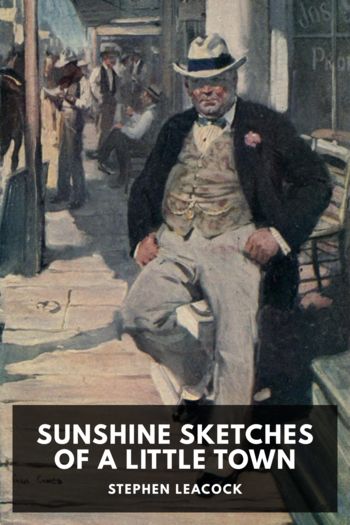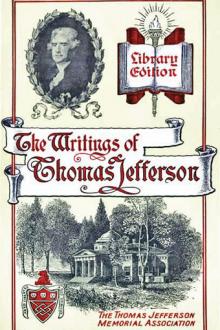Sunshine Sketches of a Little Town, Stephen Leacock [people reading books .TXT] 📗

- Author: Stephen Leacock
Book online «Sunshine Sketches of a Little Town, Stephen Leacock [people reading books .TXT] 📗». Author Stephen Leacock
Perhaps I ought to explain that when I speak of the excursion as being of the Knights of Pythias, the thing must not be understood in any narrow sense. In Mariposa practically everybody belongs to the Knights of Pythias just as they do to everything else. That’s the great thing about the town and that’s what makes it so different from the city. Everybody is in everything.
You should see them on the seventeenth of March, for example, when everybody wears a green ribbon and they’re all laughing and glad—you know what the Celtic nature is—and talking about Home Rule.
On St. Andrew’s Day every man in town wears a thistle and shakes hands with everybody else, and you see the fine old Scotch honesty beaming out of their eyes.
And on St. George’s Day!—well, there’s no heartiness like the good old English spirit, after all; why shouldn’t a man feel glad that he’s an Englishman?
Then on the Fourth of July there are stars and stripes flying over half the stores in town, and suddenly all the men are seen to smoke cigars, and to know all about Roosevelt and Bryan and the Philippine Islands. Then you learn for the first time that Jeff Thorpe’s people came from Massachusetts and that his uncle fought at Bunker Hill (it must have been Bunker Hill—anyway Jefferson will swear it was in Dakota all right enough); and you find that George Duff has a married sister in Rochester and that her husband is all right; in fact, George was down there as recently as eight years ago. Oh, it’s the most American town imaginable is Mariposa—on the fourth of July.
But wait, just wait, if you feel anxious about the solidity of the British connection, till the twelfth of the month, when everybody is wearing an orange streamer in his coat and the Orangemen (every man in town) walk in the big procession. Allegiance! Well, perhaps you remember the address they gave to the Prince of Wales on the platform of the Mariposa station as he went through on his tour to the west. I think that pretty well settled that question. So you will easily understand that of course everybody belongs to the Knights of Pythias and the Masons and Oddfellows, just as they all belong to the Snow Shoe Club and the Girls’ Friendly Society.
And meanwhile the whistle of the steamer has blown again for a quarter to seven—loud and long this time, for anyone not here now is late for certain; unless he should happen to come down in the last fifteen minutes.
What a crowd upon the wharf and how they pile on to the steamer! It’s a wonder that the boat can hold them all. But that’s just the marvellous thing about the Mariposa Belle.
I don’t know—I have never known—where the steamers like the Mariposa Belle come from. Whether they are built by Harland and Wolff of Belfast, or whether, on the other hand, they are not built by Harland and Wolff of Belfast, is more than one would like to say offhand.
The Mariposa Belle always seems to me to have some of those strange properties that distinguish Mariposa itself. I mean, her size seems to vary so. If you see her there in the winter, frozen in the ice beside the wharf with a snowdrift against the windows of the pilot house, she looks a pathetic little thing the size of a butternut. But in the summer time, especially after you’ve been in Mariposa for a month or two, and have paddled alongside of her in a canoe, she gets larger and taller, and with a great sweep of black sides, till you see no difference between the Mariposa Belle and the Lusitania. Each one is a big steamer and that’s all you can say.
Nor do her measurements help you much. She draws about eighteen inches forward, and more than that—at least half an inch more, astern, and when she’s loaded down with an excursion crowd she draws a good two inches more. And above the water—why, look at all the decks on her! There’s the deck you walk on to, from the wharf, all shut in, with windows along it, and the after cabin with the long table, and above that the deck with all the chairs piled upon it, and the deck in front where the band stand round in a circle, and the pilot house is higher than that, and above the pilot house is the board with the gold name and the flag pole and the steel ropes and the flags; and fixed in somewhere on the different levels is the lunch counter where they sell the sandwiches, and the engine room, and down below the deck level, beneath the water line, is the place where the crew sleep. What with steps and stairs and passages and piles of cordwood for the engine—oh no, I guess Harland and Wolff didn’t build her. They couldn’t have.
Yet even with a huge boat like the Mariposa Belle, it would be impossible for her to carry all of the crowd that you see in the boat and on the wharf. In reality, the crowd is made up of two classes—all of the people in Mariposa who are going on the excursion and all those who are not. Some come for the one reason and some for the other.
The two tellers of the Exchange Bank are both there standing side by side. But one of them—the one with the cameo pin and the long face like a horse—is going, and the other—with the other cameo pin and the face like another horse—is not. In the same way, Hussell of the Newspacket is going, but his brother, beside him, isn’t. Lilian Drone is going, but her sister can’t; and so on all through the crowd.
And to think that things should look like that on





Comments (0)